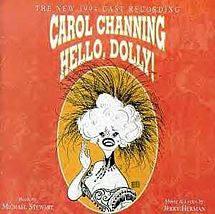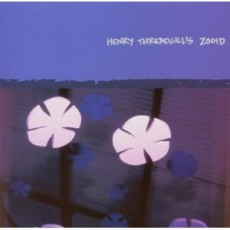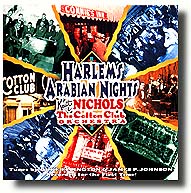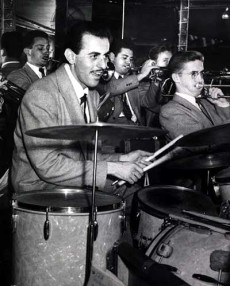
From Broadway To 52nd Street
Hello Dolly opened at the St. James Theatre on January 16, 1964 with music composed by Jerry Herman. The show starred Carol Channing & David Burns, Eileen Brennan, Sondra Lee and Charles Nelson Reilly, running for a record 2,844 performances landing it amongst the grand collection of blockbuster hits. It was revived in 1967 with Pearl Bailey & Cab Calloway in the lead roles and in 1969, Barbra Streisand & Walter Matthau took the characters to the silver screen. The title song Hello Dolly and It Only Takes A Moment went on to become a part of the jazz catalogue.
The Story: At the turn of the 20th century in New York City, a brassy and intrepid matchmaker Dolly Galagher Levi is in town to find wealthy Horace Vandergelder a wife. However, unbeknownst to Horace, Ms. Levi has her sights set on him herself. While helping two rich pretenders to find love, Dolly finds romance and a husband for herself in this spoof on love and marriage.
Broadway History: Broadway, previously the home to jazz influenced choreographers like Cole, Fosse, and Robbins, saw a part of its nature change to reflect the mood of the country. While there were still blockbuster musicals of the old type – like My Fair Lady, Hello Dolly, Mame – a new generation of musicals reflected the changes in American society, and dance. Hair was a depiction of the rebellious nature of the hippie movement. And Fosse, that champion of syncopated, tap and minstrel based movement, absorbed the new 60s feel of dance with his hit musical Sweet Charity. In this show, Fosse based much of his movement on the social dances of the 1960s, while injecting his own unique brand of style and angular movement and jutting body parts. The movements of jazz dance had evolved to absorb the blossoming social scene. Broadway was no longer the spawning ground for theatrical jazz dance. It had become a pastiche of old standard styles and movements, and an incubator for a new form of jazz dance.
Sponsored By
www.whatissuitetabu.com

Daily Dose Of Jazz…
Henry Threadgill was born February 15, 1944, in Chicago, Illinois and first performed as a percussionist in his high school marching band before taking up the baritone saxophone and later a large portion of the woodwind instruments. He soon settled upon the alto saxophone and flute as his main instruments.
He was one of the original members of the legendary AACM – Association for the Advancement of Creative Musicians in Chicago, working under the guidance of Muhal Richard Abrams before leaving to tour with a gospel band. In 1967, he enlisted in the Army, playing with a rock band in Vietnam through 1968. Discharged in 1969 he returned to Chicago, formed a trio that eventually became “Air”, one of the most celebrated and critically acclaimed avant-garde jazz groups of the 1970s and 1980s.
Threadgill had moved to New York City and began pursuing his own musical visions, exploring musical genres in innovative ways with his first nonet X-75. In the early Eighties, Threadgill created the Henry Threadgill Sextet, his first critically acclaimed ensemble as a leader, with two drummers as a single unit. He has recorded three albums under X-75 for About Time Records, reformed his sextet and released three albums on the Novus label.
Since the 90s Threadgill has continued to compose, create, perform and record music with various group configurations such as “Very Very Circus” and “Zooid” utilizing electric guitars, French horn, Latin percussion, accordion, cello and tuba.

Daily Dose Of Jazz…
Stefano di Battista was born on February 14, 1969 in Rome Italy. He began studying the saxophone at the age of 13 years in a band made up primarily of boys. It was during this period that he discovered the fun of making music. By the time he was sixteen he had become interested in jazz and the sound of Art Pepper and found his mentor, Massimo Urbani.
Enrolling in The Conservatory, Stefano perfected his technique with classical tradition, graduated with honors and by twenty-one was playing in groups of various configurations. 1992 finds him playing the Calvi Jazz Festival and is invited to perform in Paris. Traveling between Rome and Paris he lands two engagements, is hired to play with the National Jazz Orchestra and his career takes off.
Di Battista put out “Volare”, his debut as a leader in 1997, has toured with the Elvin Jones Jazz Machine as well as performing with Jimmy Cobb, Walter Booker, Nat Adderley, Laurent Cugny, Aldo Romano, Jacky Terrasson and many others. The alto and soprano saxophonist continues to record, perform and tour both as a leader and sideman.
More Posts: saxophone

Daily Dose Of Jazz…
Keith Nichols was born on February 13, 1945 in Ilford, Essex, UK and took his first music lessons at age five on piano and accordion. As a youth he was a child actor and an award-winning accordionist, Great Britain Junior Champion in 1960.
He turned professional after graduating from Gulldhall School of Music, touring with the Levity Lancers for seven years playing trombone, piano and tuba. From the early 70s he has performed in concert ragtime at London’s South Bank, came to the U.S. in 1976 with Richard Sudhalter’s New Paul Whiteman Orchestra, recorded three solo albums for EMI and is a frequent sideman for the label and formed the Midnite Follies Orchestra focusing on the music of Duke Ellington and Cab Calloway.
He has gigged and recorded with Bing Crosby, arranged for the New York Jazz Repertory Company, Dick Hyman and the Pasadena Roof Orchestra, and has worked with Harry Gold, Digby Fairweather and Claus Jacobi.
The multi-instrumentalist, arranger and award-winning accordionist in his youth continues to perform and record prolifically in the UK, America and Europe with projects based in ragtime, and lectures at the Royal Academy of Music.

Daily Dose Of Jazz…
Arthur Mardigan was born February 12, 1923 in Detroit, Michigan. As early as 1942 age 19 he was playing drums with Tommy Reynolds prior to a two-year stint in the Army. After his discharge he worked extensively on the New York City jazz scene, playing and recording with George Auld, Charlie Parker, Dizzy Gillespie, Dexter Gordon, Kai Winding, Wardell Gray and Fats Navarro.
In the 1950s he went on tour with Woody Herman and Pete Rugulo, he recorded as a leader of a sextet that included Al Cohn in 1954 for The Jazz School, recorded with Stan Getz also in 1954 and then moved back to Detroit. There he played with Jack Brokensha in 1963, returning to work with Getz near the end of his life. Drummer Art Mardigan passed away on June 6, 1977 in his hometown of Detroit.
More Posts: drums


